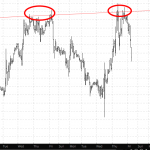Overview: The US dollar is narrowly mixed against the major currencies today, largely consolidating its recent losses. Equities are mixed. In Asia, Japan, Australia, and Hong Kong equities gained around 1%, while most other bourses were softer. In Europe, the Dow Jones Stoxx 600 is little changed in late morning turnover. Ten-year benchmark yields are mostly firmer, with Italy up three basis points, the most in Europe. Although there have been several economic reports today, investors seem mostly sidelined waiting for the US election results and FOMC meeting.

Asia-Pacific
China reported a $16 bln Q3 current account surplus. This follows a $5.3 bln surplus in Q2 and a $34 bln deficit in Q1. This means that through September, China experienced a current account deficit. The current account deficit partly reflects a deterioration in the terms of trade. The price of its imports rose relative to the price of exports. Think about oil and iron ore imports and manufactured goods exports. Also, China’s outbound tourists are picked up as service import. Still, China’s current account, like the US and Germany’s, is driven by the trade account. Other developed countries, like Switzerland and Japan, investment income balance overwhelms the trade balance in the current account calculations.
The yuan is slightly firmer today, and it is off almost 6% this year against the dollar. Although the US Treasury did not find China’s actions reach the threshold of “manipulation” and have not since 1994, Treasury Secretary Mnuchin has said he is open to changing the definition. Why is the yuan weaker against the dollar? Occam’s Razor favors simple explanations. Here’s one that seems under-appreciated: At the start of the year, China’s 10-year onshore yields was 170 bp more than the US. Now it is below 35 bp.
Japan reported a dreadful household spending data for September. Due to the natural disasters, it was accepted that consumption eased from the 2.8% pace in August, which was a three-year high. However, rather than moderate to a 1.5% pace as the median forecast would have had it, it contracted by 1.6%. This increases the chance that the world’s third-largest economy contracted in Q3, as it did in Q1. Early data for Q4 suggests growth returned.













Leave A Comment